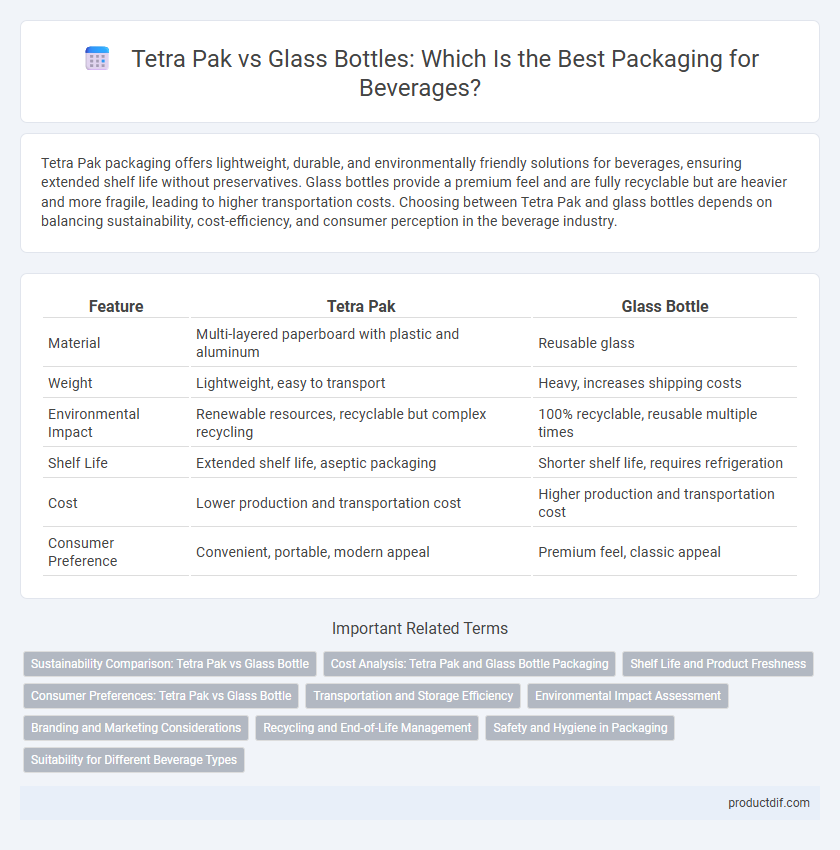Tetra Pak packaging offers lightweight, durable, and environmentally friendly solutions for beverages, ensuring extended shelf life without preservatives. Glass bottles provide a premium feel and are fully recyclable but are heavier and more fragile, leading to higher transportation costs. Choosing between Tetra Pak and glass bottles depends on balancing sustainability, cost-efficiency, and consumer perception in the beverage industry.
Table of Comparison
| Feature | Tetra Pak | Glass Bottle |
|---|---|---|
| Material | Multi-layered paperboard with plastic and aluminum | Reusable glass |
| Weight | Lightweight, easy to transport | Heavy, increases shipping costs |
| Environmental Impact | Renewable resources, recyclable but complex recycling | 100% recyclable, reusable multiple times |
| Shelf Life | Extended shelf life, aseptic packaging | Shorter shelf life, requires refrigeration |
| Cost | Lower production and transportation cost | Higher production and transportation cost |
| Consumer Preference | Convenient, portable, modern appeal | Premium feel, classic appeal |
Sustainability Comparison: Tetra Pak vs Glass Bottle
Tetra Pak cartons are lightweight, recyclable, and have a lower carbon footprint in transportation compared to glass bottles, which are heavier and require more energy for shipping. Glass bottles excel in reusability and can be recycled infinitely without loss of quality, contributing to circular economy benefits. However, the overall environmental impact depends on factors like local recycling infrastructure, energy sources, and lifecycle assessments for both packaging types.
Cost Analysis: Tetra Pak and Glass Bottle Packaging
Tetra Pak packaging offers lower production and transportation costs compared to glass bottles due to its lightweight and space-efficient design, reducing freight expenses significantly. Glass bottles incur higher costs associated with raw materials, energy-intensive manufacturing, and increased breakage during shipping. The overall cost analysis favors Tetra Pak for high-volume beverage distribution, while glass bottles may incur premium pricing linked to recycling and brand positioning.
Shelf Life and Product Freshness
Tetra Pak packaging extends beverage shelf life by providing airtight, light-resistant, and oxygen-barrier properties that preserve product freshness longer than traditional glass bottles. Glass bottles offer excellent inertness and maintain flavor integrity but are more susceptible to light exposure and oxygen permeation, which can reduce shelf life. For perishable beverages like juices and dairy, Tetra Pak's multi-layered structure effectively prolongs freshness and reduces the need for refrigeration compared to glass containers.
Consumer Preferences: Tetra Pak vs Glass Bottle
Consumer preferences reveal a growing demand for Tetra Pak due to its lightweight convenience, portability, and eco-friendly reputation stemming from its renewable packaging materials. In contrast, glass bottles attract consumers valuing premium quality perception, taste preservation, and recyclability, with a preference for reusable packaging. Market trends indicate young, environmentally conscious consumers lean towards Tetra Pak, while traditionalists and niche markets favor glass for its premium and sustainable appeal.
Transportation and Storage Efficiency
Tetra Pak cartons offer superior transportation and storage efficiency compared to glass bottles due to their lightweight and compact design, which reduces shipping volume and lowers fuel consumption. Unlike fragile glass bottles, Tetra Pak's durable structure minimizes breakage and allows for more efficient stacking in warehouses and retail spaces. This results in lower transportation costs and optimized storage capacity, making Tetra Pak a sustainable choice for beverage distribution.
Environmental Impact Assessment
Tetra Pak cartons typically have a lower carbon footprint than glass bottles due to their lighter weight and more efficient transportation logistics, resulting in reduced greenhouse gas emissions. Glass bottles, while fully recyclable and reusable, require significantly more energy for production and transportation because of their heavier mass, contributing to higher environmental impacts. Lifecycle assessments show that the environmental benefits of Tetra Pak hinge on effective municipal recycling systems, whereas glass bottles' impact decreases with higher rates of reuse.
Branding and Marketing Considerations
Tetra Pak packaging offers brands enhanced flexibility with vibrant, customizable graphics that attract consumers and boost shelf visibility, supporting effective storytelling and brand differentiation. Glass bottles convey premium quality and sustainability, resonating with eco-conscious consumers and enabling brands to leverage authenticity and heritage in marketing campaigns. Choosing between Tetra Pak and glass bottles hinges on brand positioning goals, target audience preferences, and sustainability narratives to maximize marketing impact.
Recycling and End-of-Life Management
Tetra Pak cartons combine paperboard, plastic, and aluminum layers, requiring specialized recycling facilities to separate and process materials efficiently, whereas glass bottles are widely recyclable through established glass recycling systems that enable repeated reuse without quality loss. End-of-life management for glass bottles emphasizes circular economy principles through multiple refill cycles and high-value recycling, while Tetra Pak's complex composition challenges recycling rates but supports waste-to-energy recovery where material separation is limited. Optimizing recycling infrastructure and consumer sorting behavior significantly impacts the environmental footprint and resource recovery of both packaging types in the beverage industry.
Safety and Hygiene in Packaging
Tetra Pak packaging offers superior safety and hygiene through its aseptic processing, which eliminates the need for preservatives and extends shelf life without refrigeration. Glass bottles, while recyclable and inert, can pose contamination risks if not properly sterilized and sealed. The multi-layer structure of Tetra Pak prevents microbial infiltration, making it a preferred choice for maintaining beverage purity and safety.
Suitability for Different Beverage Types
Tetra Pak cartons excel in preserving shelf-stable beverages like juices, milk, and plant-based drinks by providing airtight packaging that extends freshness and prevents contamination. Glass bottles are ideal for carbonated drinks, craft beers, and premium juices, offering excellent flavor retention and a premium consumer experience. The choice between Tetra Pak and glass bottles depends on beverage sensitivity, shelf life requirements, and consumer preferences for sustainability and recyclability.
Tetra Pak vs Glass Bottle Infographic

 productdif.com
productdif.com